Coevolution
Research group on 'Coevolution of Galaxies and Black Holes' at MPIA
Projects
Published projects:
- The dynamical mass of a z=1.3 AGN host galaxy from VLT/SINFONI NIR integral field spectroscopy. (07/2011, update 09/2011)
- No merger-AGN connection since z=1 (11/2010, update 01/2011)
- The non-causal origin of the black hole-galaxy scaling relations (06/2010)
- A near-IR study of the host galaxies of 2Jy radio sources (05/2010)
- HE0450-2958: A quasar, a ULIRG, a merger, galaxy formation live and in color! (11/2009)
- The evolution of the MBH-Mstellar-relation over the last 9 Gyrs (09/2009)
- Determining the bulge- or stellar mass vs. Black Hole-mass relation of galaxies out to z>2 and constrain its evolution over 10 Gyrs using data from the GEMS and COSMOS galaxy surveys with the HST and Laser Guide Star Adaptive Optics assisted Integral Field Spectroscopic data from SINFONI at ESO VLT.
The dynamical mass of a z=1.3 AGN host galaxy from VLT/SINFONI NIR integral field spectroscopy
K. J. Inskip, K. Jahnke, H.-W. Rix and G. van de Ven, 2011, ApJ, 739, 90
30. Sep. 2011: Please note the MPIA press release on this project.
Measuring masses of galaxies is difficult. This is true in the local universe and becomes more acute the larger the distance. It is particularly true for galaxies with a bright active galactic nucleus (AGN) in their center. In order to study the relative growth of supermassive black holes and their hosting galaxies it is required to determine both masses with as small systematic errors as possible. However, as mass is not an observable, it has to be inferred from other observables - a process with intrinsic uncertainties.
At redshifts z~1.5, when the Universe was only 1/3 of its present age star formation and black hole accretion were near their historic peak. During this era we expect the strongest signs for a joint evolution of galaxies and black holes or, if their growth is unconnected, a potentially strong difference in their relative growth.
We set out to derive the total mass of a sample of 10 AGN host galaxies at z=1 to 2, for the first time by measuring the velocity field of their ionised gas to infer an enclosed dynamical mass. This has been done for high redshift QSOs using molecular CO emission lines and mm-interferometry, which is restricted to the most molecular gas-rich and most star-forming galaxies. We set out to expand the vast potential of this method to more "normal" AGN by using the velocity field from rest-frame optical emission lines, in our case narrow Halpha emission.
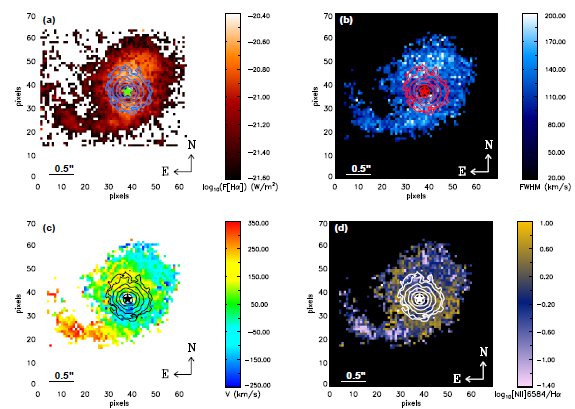 Maps of Halpha flux (top left), velocity dispersion (top right), derived velocity field (bottom left) and Halpha/[NII] line ratios (bottom right) of the QSO SDSS J090543.56+043347.3 at a redshift z~1.3, using the VLT/SINFONI IFU with laser AO. From Inskip et al. 2011.
Maps of Halpha flux (top left), velocity dispersion (top right), derived velocity field (bottom left) and Halpha/[NII] line ratios (bottom right) of the QSO SDSS J090543.56+043347.3 at a redshift z~1.3, using the VLT/SINFONI IFU with laser AO. From Inskip et al. 2011.
Using the SINFONI integral field spectrograph at the ESO VLT together with the laser-guide-star assisted adaptive optics mode, we were able to measure the two-dimensional emission line distribution and -velocities in a number of AGN. For a first QSO, SDSS J090543.56+043347.3 at a redshift z~1.3, we removed the bright point source emission by the AGN from the data and modelled the remaining narrow emission line velocity field. The resulting dynamical mass of 2x1011 Msun enclosed in a radius of 5.25 kpc can be compared to the black hole mass 9x108 Msun we inferred from the same dataset. This ratio is very similar to the ratio for local galaxies and is an indication that the relations between black holes and galaxies has not dramatically changed between z=1.5 and today.
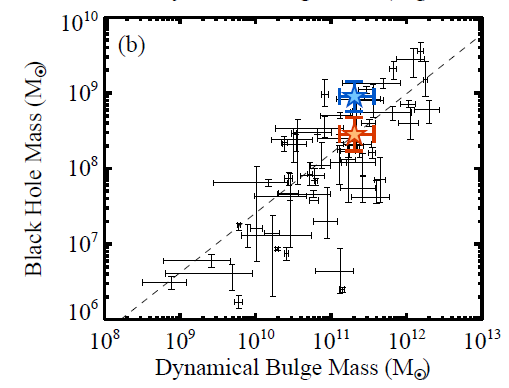 Relation of black hole and dynamical mass. Black points and regression line are value at z=0 from Häring&Rix (2004) and Sani et al. (2011), the red large symbol is SDSS J090543.56+043347.3 at z~1.3. The blue symbol marks an old, less reliable measurement of black hole mass. This shows that the evolution of this relation since z=1.3 to today can only be very modest. From Inskip et al. 2011.
Relation of black hole and dynamical mass. Black points and regression line are value at z=0 from Häring&Rix (2004) and Sani et al. (2011), the red large symbol is SDSS J090543.56+043347.3 at z~1.3. The blue symbol marks an old, less reliable measurement of black hole mass. This shows that the evolution of this relation since z=1.3 to today can only be very modest. From Inskip et al. 2011.
When estimating the conversion of stellar mass from the galaxy's disk to its bulge, the expected stellar mass growth through starformation and its black hole mass growth from accretion, we come to the conclusion that most of the black hole growth and stellar mass growth must have occurred at earlier times and that the state of the galaxy will not change drastically in the 9.5 billion years between z=1.3 and today.
kj, 19.07.2011
No merger-AGN connection since z=1
M. Cisternas, K. Jahnke, K. Inskip et al. (incl. R. Andrae), 2011, ApJ, 726, 57
05. Jan. 2011: Please note the ESA/MPIA press release on this project.
Which mechanism provides inflowing gas to feed the supermassive black holes (BHs) in galaxy centers? Since the existence of such BHs was found through the discovery of active galactic nuclei (AGN) and quasars four decades ago, it was clear that gas would not automatically flow into towards central BHs - they are not vacuum cleaners. Instead gas in the galaxy has to loose angular momentum, in order to flow into the center. Since the beginning it was unclear how this happens on scales of less than a parsec, the "angular momentum problem".
Several mechanisms have been proposed, for massive galaxies the most important was deemed to be galaxy merging. In a collision of two galaxies their gas is stirred up and in a turbulent mixing enough gas might receive zero angular momentum with respect to the BH and subsequently would fall in. Several seminal papers proposed such a scenario, but over the last 20 years there were no clear results found with a range of studies finding either an excess or no excess of merger signatures for AGN in comparison to inactive galaxies. Partially this was due to comparisons of active and inactive galaxies coming from different data sources with different instruments, wavelengths, observational depths and spatial resolutions.
The COSMOS survey with the Hubble Space Telescope (HST) offered the so far best opportunity to change this. Drawing from a treasure of data in the 2 square degree COSMOS field ranging from the X-ray to radio as well as exploiting the dedicated high resolution HST imaging, it was possible to carry out a unique test: AGN galaxies and inactive galaxies were available with the same HST data, yielding deep high spatial resolution imaging for ~150 AGN up to redshift z=1 and a much larger amount of comparison galaxies. The sample of AGN represents high-luminosity Seyfert galaxies and lower to intermediate luminosity quasars - the population dominating black hole growth in the time since redshift z=1.
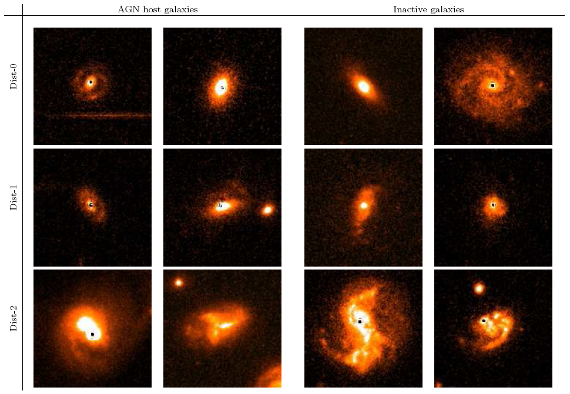 Example galaxies of smooth (top), slightly (middle) and heavily distorted (bottom) galaxies. AGN are on the left and normal galaxies on the right. 10 people independently and without knowing about the activity classified 1400 galaxies into these three classes. From Cisternas et al. 2011.
Example galaxies of smooth (top), slightly (middle) and heavily distorted (bottom) galaxies. AGN are on the left and normal galaxies on the right. 10 people independently and without knowing about the activity classified 1400 galaxies into these three classes. From Cisternas et al. 2011.
We used these data to carry out a 1:1 comparison of signatures for distortions - relics of a recents (<300 Myr) major interaction or merging event - for the AGN and an inactive sample of galaxies matched my redshift and flux. A blind classification by 10 people - non of them knew which galaxy was an AGN and which was inactive - enabled the first statistically discriminating statement of whether galaxy merging was indeed the dominating fuelling mechanism for BHs or not.
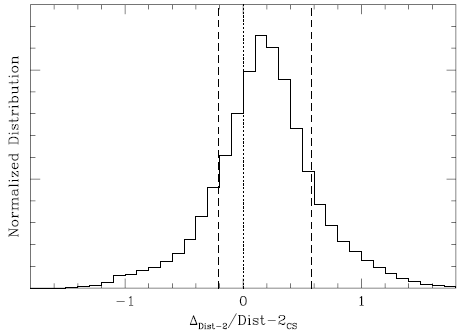 Combining the impression of 10 people into one number: Given the size of the sample this is the probability distribution that there is a difference in "strong distortions" between the AGN and inactive galaxies. A higher fraction of distorted AGN would mean a positive, more distorted inactive galaxies negative value. Within the uncertainties (the central 68% probability interval is marked by the vertical dashed lines) the fraction of strongly distorted systems is identical in both samples and clearly not higher than a factor of 2 for the AGN sample. From Cisternas et al. 2011.
Combining the impression of 10 people into one number: Given the size of the sample this is the probability distribution that there is a difference in "strong distortions" between the AGN and inactive galaxies. A higher fraction of distorted AGN would mean a positive, more distorted inactive galaxies negative value. Within the uncertainties (the central 68% probability interval is marked by the vertical dashed lines) the fraction of strongly distorted systems is identical in both samples and clearly not higher than a factor of 2 for the AGN sample. From Cisternas et al. 2011.
The answer is: It is not. There is no statistically significant excess of a merger signature for AGN compared to normal galaxies. AGN merge as any galaxy of the same mass does. Due to the size of the sample, this is not just a result of a too large uncertainty: We can at the same time rule out that compared to the background level of distortions of ~15% the distortion rate for AGN is on a 95% confidence level higher than ~30%. This means the distortion rate for AGN is at maximum twice as high and 70% of AGN at any time since z=1 have not had a major merger anytime recent at all. Hence recent (<300Myr) galaxy merging is not the dominating mechanism triggering BH growth. More "secular" mechanisms as gravitational instabilities of the gas disks or disruptions by minor mergers have to be dominating the last 8 billion years.
kj, 04.11.2010, updated 19.07.2011
The non-causal origin of the black hole-galaxy scaling relations
K. Jahnke & A. Maccio, 2011, ApJ, 734, 92
Most, if not all massive galaxies contain a supermassive black hole in their centers. The black holes, who can have masse of a million or even more than a billion times the mass of our sun, have been suspected since a decade to be involved in the late-stage evolution of their host galaxies. How so?
If gas comes near the black hole it will be subject to very much friction and will heat up and emit large amounts of electromagnetic radiation before it falls into the black hole. This light from the then active galactic nucleus (AGN) contains over time more energy than the gravitational binding energy of the gas and stars in the surrounding galaxy. It was suspected and observed that some of that energy coupled to the gas in the galaxy and heated it up, preventing further star formations. This process was christened "AGN feedback".
Around 1998 it was recognized that not only do black holes exist in every galaxy, but the masses of the black holes scaled very tightly with the mass of the host galaxies bulge, and the velocity dispersion of its stars. These scaling relations were generally interpreted as a coupled evolution of black hole and stellar bulge - despite the black hole being smaller in linear size by up to 9 orders of magnitude. The main idea was that when galaxies were colliding, not only their components coalesced, but also that gas was funneled down to the black hole, causing growth, but also AGN feedback. Hence changes in the black hole mass would immediately imply changes in the galaxy.
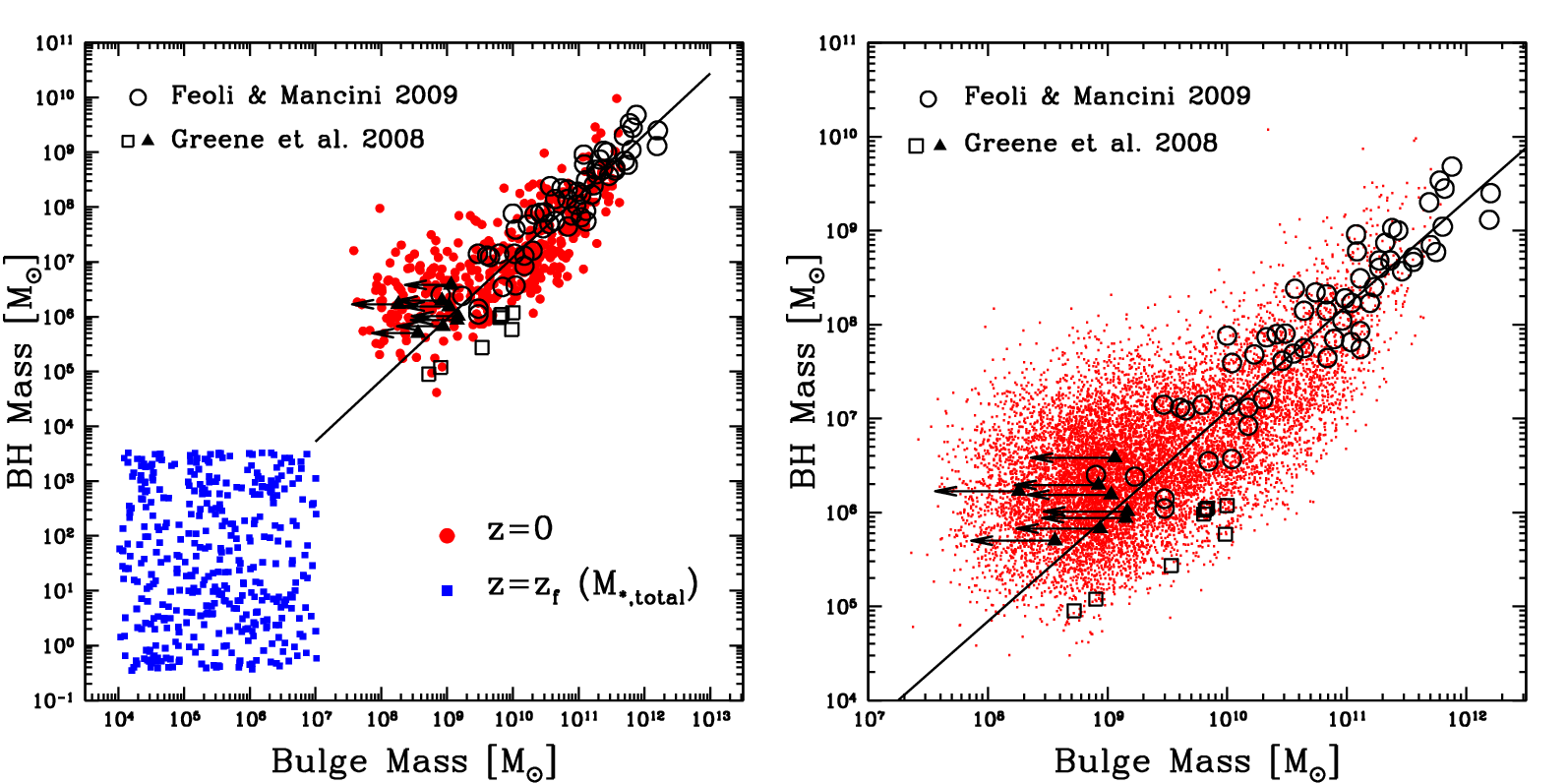 Results of the simulations and comparison to observed data. Left: Initial uncorrelated high redshift seeds for stellar and and black hole mass (blue filled squares) and resulting z=0 MBH–Mbulge scaling relation for a subset of 400 randomly selected merger trees (red points), compared to the observed local relation in black, including the compilation from (Feoli & Mancini 2009, circles), low-mass spheroids (open squares) and upper limits for spiral bulges (triangles) from Greene et al. (2008). The solid line is the linear fit by Häring & Rix (2004) with a slope of 1.12. Right: The full set of resulting 10932 galaxies at z = 0 with the low–z data overplotted. From Jahnke & Maccio 2010.
Results of the simulations and comparison to observed data. Left: Initial uncorrelated high redshift seeds for stellar and and black hole mass (blue filled squares) and resulting z=0 MBH–Mbulge scaling relation for a subset of 400 randomly selected merger trees (red points), compared to the observed local relation in black, including the compilation from (Feoli & Mancini 2009, circles), low-mass spheroids (open squares) and upper limits for spiral bulges (triangles) from Greene et al. (2008). The solid line is the linear fit by Häring & Rix (2004) with a slope of 1.12. Right: The full set of resulting 10932 galaxies at z = 0 with the low–z data overplotted. From Jahnke & Maccio 2010.
We have now submitted an analysis, in which we test whether one actually needs a driving physical mechanism behind the formation of the observed scaling relations. It was suggested in a thought experiment that the merger cascade of galaxies alone should have a "central limit theorem"-like effect, meaning that any initial scatter in the relation between black hole and bulge mass would be averaged out with more and more successive galaxy mergers, while at the same time a mass function of galaxies was built up. We now tested this idea with a realistic set of "merger trees", i.e. we followed simulations of an initial 6.5 million galaxies from the early Universe to today, when they have successively merged into a final ~10.000 galaxies.
The results show that it is really the merger cascade itself that produces the scaling relations. Any of the star formation and black hole growth mechanisms that can be thought of might modify these relations, but they are not their cause.
This has implications for the importance of the proposed AGN feedback: While some incarnations of it are seen at work, it is not known how important it is on the global scale. Our results now take away one aspect where it was often thought to be required. There are other issues in galaxy formation theory (color-magnitude distribution of galaxies, top end of the mass function) which continue to require extra mechanisms beyond simple merging, but as we show, these are independent of the creation of the black hole-galaxy scaling relations.
kj, 04.06.2010
A near-IR study of the host galaxies of 2Jy radio sources
K. Inskip, et al. 2010, MNRAS, in press
The 2Jy sample of southern radio sources at z<0.5 is one of the best-studied radio galaxy samples in existence; the wealth of imaging and spectroscopic data existing for this sample over a wide range of wavelengths make it ideally suited for addressing a number of different science goals. In this work, we apply GALFIT to near-IR imaging data in order to study the morphological characteristics of the host galaxies of powerful radio galaxies at (relatively) low redshifts. This study is part of a larger investigation into the links between galaxy growth and radio source/AGN activity, and in particular the nature of radio source triggering.
We find that while the majority of sources are hosted by apparently passively evolving massive elliptical galaxies well modelled by a Sérsic profile with an index of n=4, with scale sizes of the order of 10kpc, morphological fits to approximately one third of the sample require either a Sérsic index of n=1-2, or the presence of a disk-like component in addition to the main galactic bulge. Roughly 50% of the sample are either disturbed systems or clearly undergoing interactions with companion objects.
Subsequent papers in this series (in preparation) address the links between morphological status and the recent and ongoing star formation activity in these sources
[WIP - more text and figures to be added]
ki, 18.05.2010
HE0450-2958: A quasar, a ULIRG, a merger - galaxy formation live and in color! Is it also a "Black Hole Caught Zapping Galaxy into Existence?"
D. Elbaz, K. Jahnke, et al. 2009, A&A, 507, 1359 and
K. Jahnke, D. Elbaz, et al. 2009, ApJ, 700, 1820
30. Nov. 2009: Please note the ESA/MPIA press release on this project.
HE0450-2958 is a comparably nearby quasar at a redshift of z=0.186. It's part of a peculiar and strange system, in interaction with a companion galaxy only 6.5kpc away. In earlier studies it was speculated whether HE0450-2958 had an unusually low-mass host galaxy - up to now, no host galaxy was detected around the quasar. One of the possible explanations is a screen of dust that could absorb most of the host galaxy's emission, hiding it from our view.
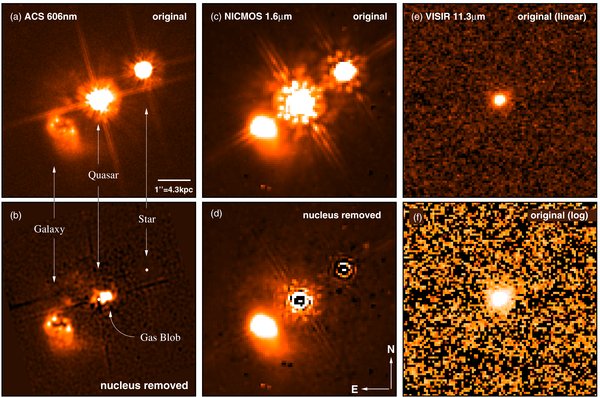 HE0450-2958. Left: optical wavelengths (HST/ACS, I-band), center: near-infrared (HST/NICMOS, H-band), right: mid-infrared (ESO VLT/VISIR, 11.3mu). Top row panels (a)+(c) show the full HST images, while in panels (b)+(d) the quasar emission is removed. The VISIR image only shows a single point source, the quasar, plus a very faint signature of the companion galaxy. From Jahnke, Elbaz et al. 2009.
HE0450-2958. Left: optical wavelengths (HST/ACS, I-band), center: near-infrared (HST/NICMOS, H-band), right: mid-infrared (ESO VLT/VISIR, 11.3mu). Top row panels (a)+(c) show the full HST images, while in panels (b)+(d) the quasar emission is removed. The VISIR image only shows a single point source, the quasar, plus a very faint signature of the companion galaxy. From Jahnke, Elbaz et al. 2009.
For this reason we used new imaging data in the infrared, that both penetrates dust, but also allows to detect warm dust by its characteristic radiation, to test the nature of this system. We acquired new images with the Hubble Space Telescope and its NICMOS near-infrared camera at a wavelength of 1.6mu as well as a mid-infrared image at 11.3mu from the ESO Very Large Telescope and the VISIR instrument. By combining these with existing data in the optical, radio and millimeter wavelengths we looked for and behind a potential dust screen
While our observational limits with NICMOS still did not allow to see the bulk mass of the host galaxy, we found that while no large amounts of obscuring dust are present arount the quasar, the derived upper limit are in agreement with predictions made from estimates of its central black hole mass. Furthermore, we identified a potential extension, slightly removed from the quasar center that is likely a part of the host galaxy, possibly a remnant from a violent interaction with the companion galaxy. This black hole-galaxy system in this respect is quite normal.
More importantly our new infrared data allowed to characterize the dust distribution also in the companion galaxy. We found a layer of optically thick dust is obscuring the view into the heart of the companion, which is producing stars at a frantic rate of ~340 solar masses per year - 100 times more than ususal. The companion is a star-formation powered Ultraluminous Infrared Galaxy (ULIRG) while our 11.3mu image showed that the quasar nucleus itself emits similar amounts of infrared radiation, put powered by the quasar nucleus. This system shows impressively that black hole growth and star-formation do necessarily occur in the same geometric location.
As an interpretation of a strong radio jet emitted by the quasar towards the companion galaxy, we speculate whether some or a substantial amount of the star-formation in the companion could in fact we triggered by the jet. Since quasar host and companion galaxy with enavitably merge into a single system in the future, the quasar would in this case stimulate the build-up of its own host galaxy. This is a route of "quasar feedback" that has not yet been widely explored in theoretical works. If it is effective, it could play an important role in galaxy formation in the earlier Universe.
kj, 25.11.2009
The evolution of the MBH-Mstellar-relation over the last 9 Gyrs: Combining COSMOS HST/ACS and HST/NICMOS imaging
K. Jahnke, M. Cisternas, K. Inskip, et al. 2009, ApJL, 706, 215
We investigate the masses of the host galaxies of quasars at redshift around z=1.4, and relate them to the masses of their central black holes. Using a sample of 10 quasars from the COSMOS survey (of Mstellar~1011.2 Msun and MBH~108.2 Msun) we find that the black hole mass follows the same linear relation with the total stellar mass of the host galaxies at z=1.4 as we find for the bulge stellar mass in the local Universe.
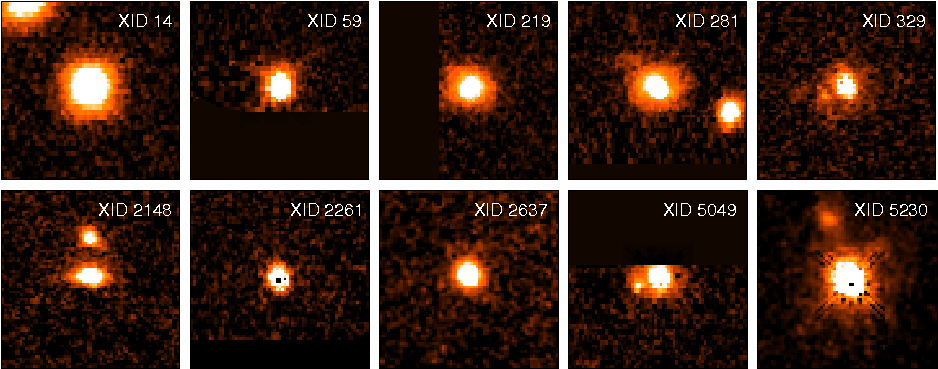 The host galaxies of the 10 quasars of the study: HST/NICMOS H-band images after removal of the active nuclei
The host galaxies of the 10 quasars of the study: HST/NICMOS H-band images after removal of the active nuclei
An interpretation of this depends on whether the host galaxies are very much pure spheroids or if whether they have substantial disk components. In the former case our results mean that over the last 9Gyrs neither bulge and black hole did not grow with respect to each other. In the latter case we conclude that we see bulge growth from redistribution of preexisting disk stars through galaxy mergers or disk instabilities.
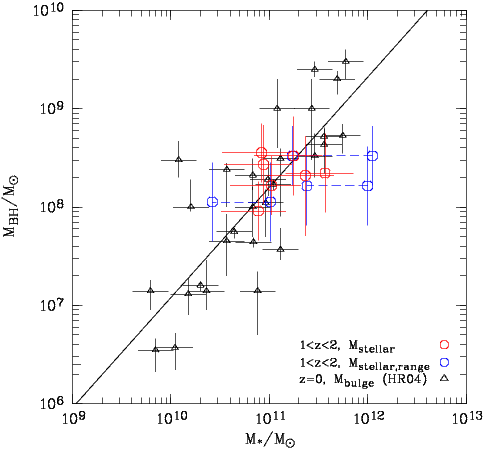 | MBH-Mstellar-relation for bulge-only masses at z=0 (black points and line) and for total masses at z=1.4 (red points and blue ranges).
| MBH-Mstellar-relation for bulge-only masses at z=0 (black points and line) and for total masses at z=1.4 (red points and blue ranges).
It is necessary in the future to test the second interpretation at different redshifts and stellar masses, since this has implications for the concept of "AGN feedback". In this case the existence of a tight relation between BH and bulge mass at z=0 is not due to a direct regulation loop including quasar activity that drives out gas from the galaxy. Instead, the connection can be much looser and possibly be due to the statistics of galaxy merging and disk-to-bulge conversion in this process.
kj, 06.11.2009


